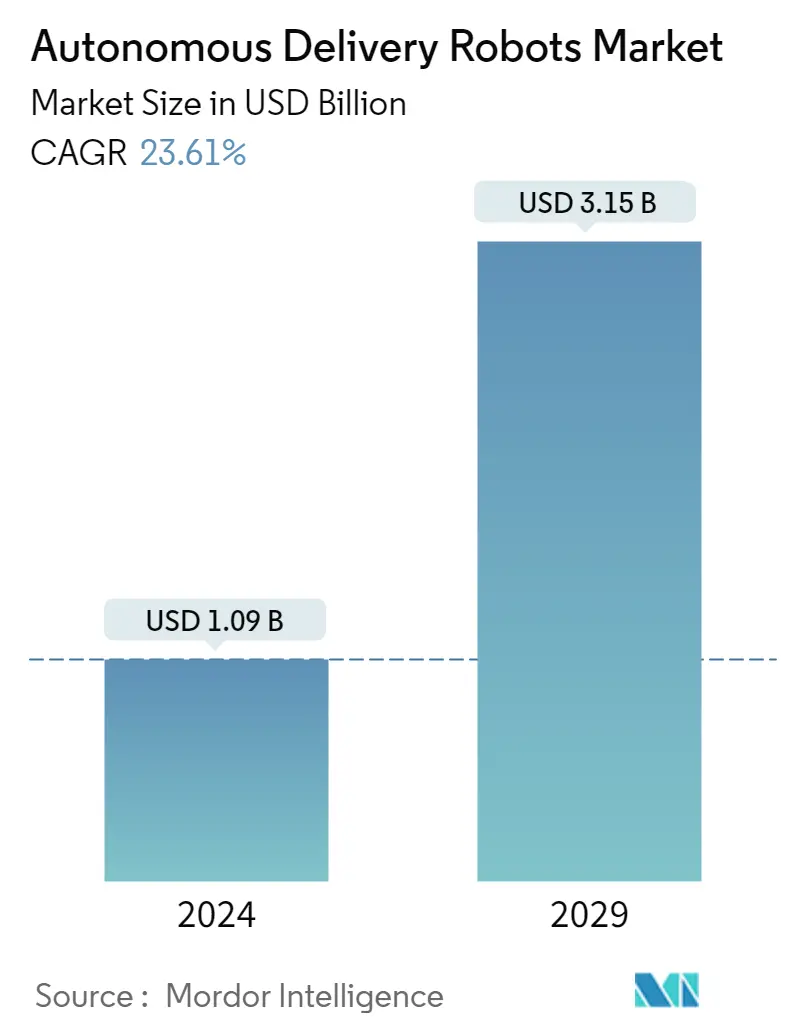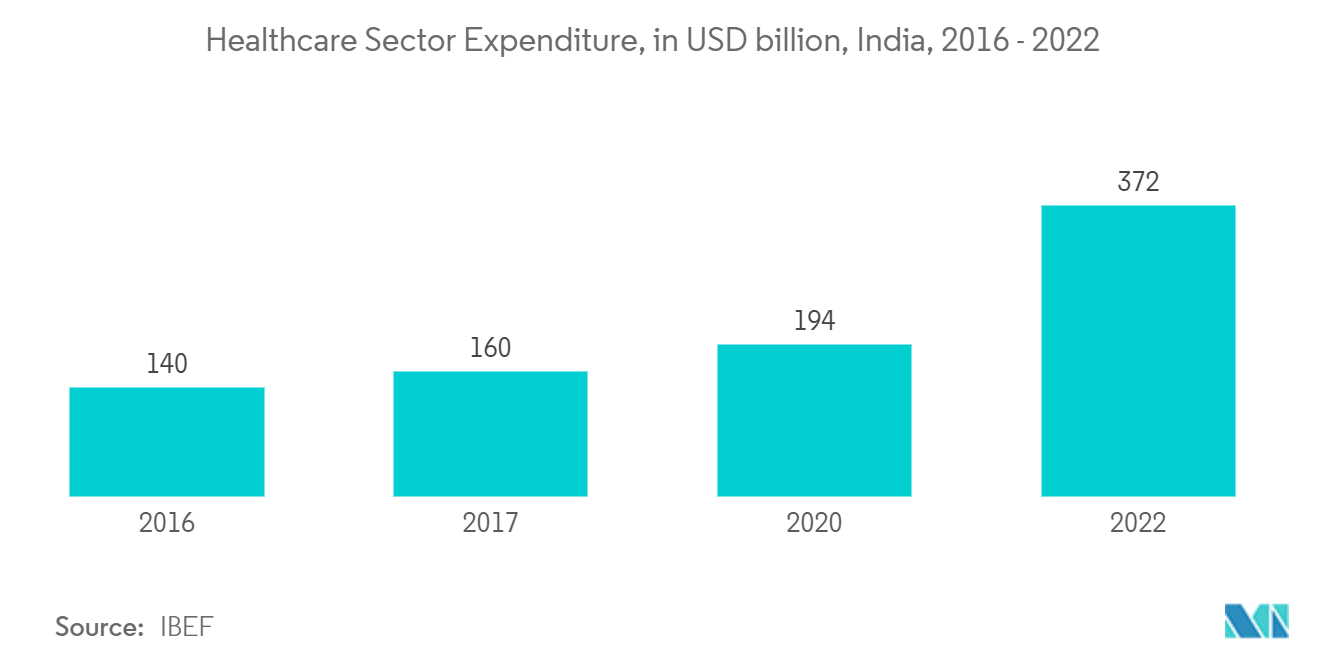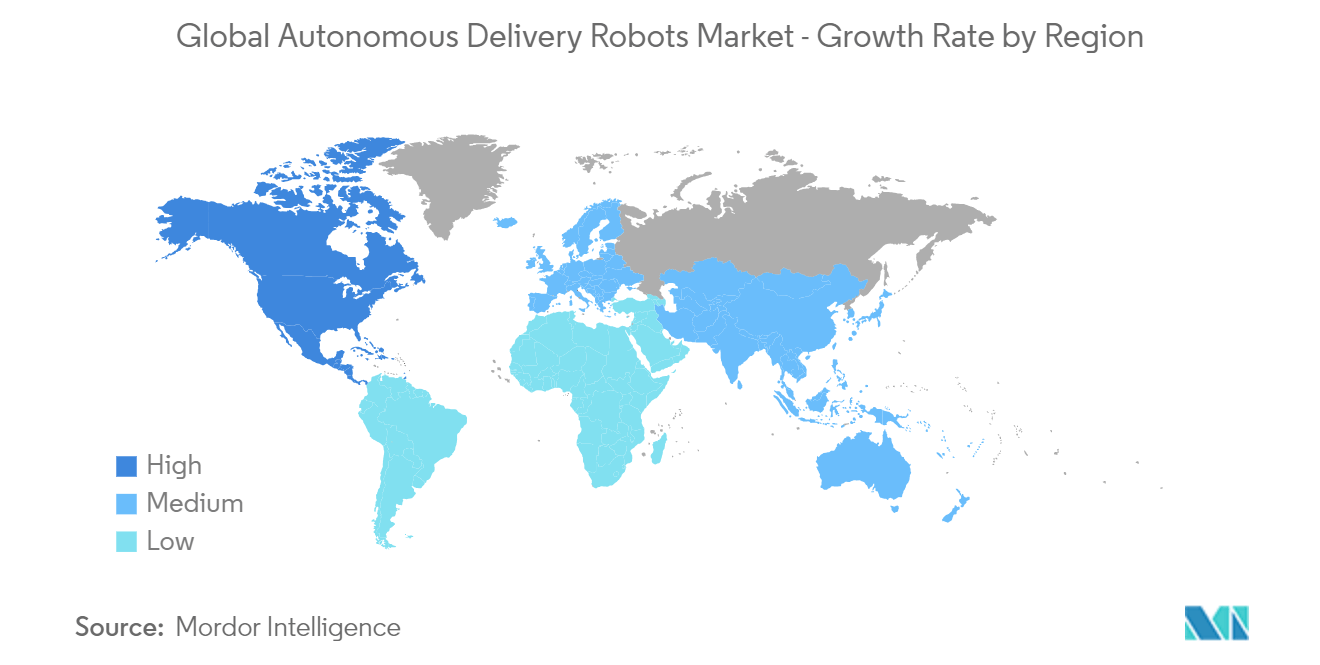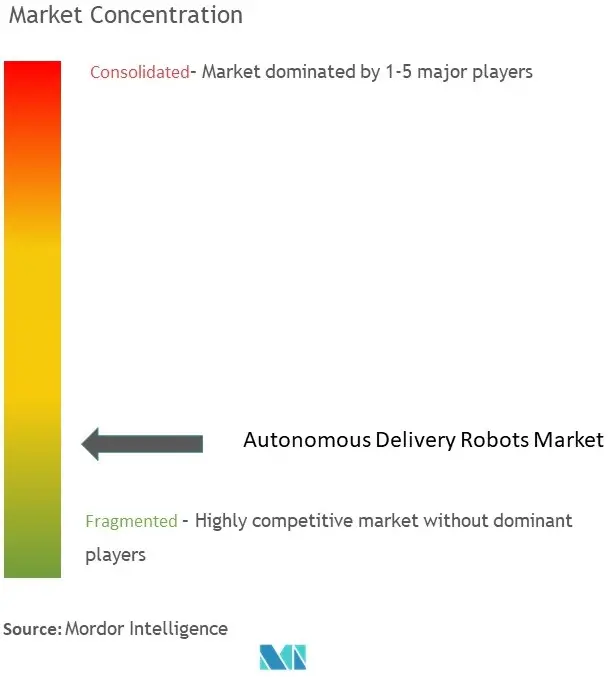Autonomous Delivery Robots Market Size

| Study Period | 2021 - 2029 |
| Market Size (2024) | USD 1.09 Billion |
| Market Size (2029) | USD 3.15 Billion |
| CAGR (2024 - 2029) | 23.61 % |
| Fastest Growing Market | Asia Pacific |
| Largest Market | North America |
Major Players
*Disclaimer: Major Players sorted in no particular order |
Autonomous Delivery Robots Market Analysis
The Autonomous Delivery Robots Market size is estimated at USD 1.09 billion in 2024, and is expected to reach USD 3.15 billion by 2029, growing at a CAGR of 23.61% during the forecast period (2024-2029).
The increasing use of autonomous delivery automobiles due to their efficiency is the primary element contributing to the Market's growth. In January 2022, Ottonomy launched Ottobots, a fleet of fully autonomous delivery robots for restaurant and retail industries for outdoor and indoor environments. The pandemic provided Ottobots with a catalyst enabling a series of partnerships that allowed it to launch fully autonomous delivery for curbside, indoor, and last-mile deliveries.
- Autonomous delivery robots (ADR) have revolutionized delivery procedures, providing a cheaper and more efficient way of delivery. Though delivery robots did not experience high adoption in the past, they are expected to notice increased growth in the future, owing to numerous advantages. The increasing adoption of ADR is mainly driven by the growing affordability and return on investment of a rising variety of infrastructure light robots, along with continuing needs for flexible and efficient automated fulfillment. For instance, in January 2022, Starship Technologies, a significant player in autonomous delivery robots, picked up EUR 50M from the European Union (EU) investment arm to extend its fleet of autonomous delivery robots.
- AI and ML have also greatly benefited the food processing industry, eateries, restaurants, and diners. These technologies, among other things, have sped up the supply chain process and enhanced food delivery services.
- Furthermore, last-mile delivery has been one of the primary problems in handling the supply chain. Last-mile deliveries are getting increasingly complicated in cities, as continued growth in e-commerce and high consumer expectations for faster and regular deliveries are causing traffic congestion and increased carbon pollution. According to the World Economic Forum, the need for last-mile delivery is predicted to grow by 78% globally by 2030
- Losses of about USD 333m incurred due to shipping mishaps, according to the National Retail Federation (NRF). Due to such delivery issues, various consumers and retailers have been looking for better and more efficient delivery methods.
- Also, many retailers have discovered that a superior last-mile experience engages and retains consumers. However, at the same time, meeting customers' delivery expectations does not assist in increasing profit margins, as today's retailers are soaking a part of the cost of last-mile delivery. Therefore, ADR is helping these companies in achieving efficient last-mile delivery.
- Moreover, the logistics sector consumes several natural resources to sustain different operations, such as the delivery of goods. This has also contributed to global warming by disposing of large amounts of greenhouse gases into the atmosphere. Autonomous delivery systems are anticipated to counter such anti-environmental effects by reducing CO2 emissions in the atmosphere.
- Multiple laws are being put in place to control global warming and protect the environment; such initiatives undertaken by governments contribute to the demand growth of ADRs in the Market. For instance, the European Commission has set an objective of decarbonization by 2050, with a few immediate goals in 2020 and 2030.
- Moreover, the government of Delhi recently shared a draft that mandates EVs to cab aggregators, food delivery firms, and E-commerce platforms by 2030. As per officials, the government aims to increase the EV share in overall vehicle sales to 25% by the year 2024. Such activities may further hamper the growth of delivery robots in the Market.
- The COVID-19 pandemic focused attention on delivery robots for contactless package deliveries worldwide, and strong market demand has pushed delivery robot developers to launch large-scale operations in several US cities. The deployment and adoption of delivery robot technology are anticipated to strengthen the Market for delivery robots in the forecasted period. Increasing logistic and healthcare spending worldwide may further drive market growth. According to WHO, the global current health expenditure as a share of the GDP is forecasted to increase between 2023 and 2028 by 0.2% points, and the share is estimated to amount to 10.81% in 2028.
Autonomous Delivery Robots Market Trends
Healthcare Segment is Expected to Register a Significant Growth
- Healthcare applications are one of the considerably advanced forms of autonomous delivery robots. Unlike outdoor delivery robots, autonomous delivery robots deployed in healthcare applications need to consider several other parameters, such as low noise motors, sanitation parameters, and smoother travel compared to regular deliveries.
- Traditionally, robots were installed in several medical establishments for therapeutic use for kids. But now, they are even used to assist the medical staff in fetching the required resources on demand. For example, consider the case of Aethon, a prominent robotics manufacturer based in the US, which offers TUG Robots for medical applications.
- In addition, the TIAGo Delivery and TIAGo Conveyor robots were deployed at the Hospital Municipal of Badalona and Hospital Clínic Barcelona. At the Hospital of Badalona, Sergio Garcia Redondo of the Innovation and Projects Department believes that based on the two use cases they have tested, it's seen a lot of potential, and they will undoubtedly improve the hospital's logistics. And also, the hospital would drastically be able to reduce the necessity to do repetitive tasks with no added value for the patient. Therefore the healthcare staff could concentrate directly on the patient.
- Also, these robots are being utilized at Omaha VA Medical Center to fetch and drop medical supplies on demand. They also sustain the facility by delivering several logistical things and lab samples. In addition, Sheba Medical Center recently partnered with Seamless Vision, an Israeli startup, to create an innovative Autonomous Logistics Infrastructure. The firm plans to launch autonomous medication delivery to patients to ease the pressure on hospital staff in the coming years.
- According to the Bureau of Labor Statistics (BLS), the requirement for nurses is expected to increase by 16%, reaching 3.2mm in 2024 the United States. The aging baby boomers who require additional care will propel much of the growth. Moreover, the spending on healthcare applications is increasing daily, implying the adoption of autonomous delivery robots. For instance, according to IBEF, expenditure on healthcare in India amounted to USD 372 billion in 2022, an increase from the previous year, which was recorded to USD 194 billion.
- Additionally, Aster DM Healthcare declared that it is planning INR 900 crores (USD 120.97 million) capital expenditure over the next three years to enhance its presence in India as it looks at increasing the share of the revenue from the country to 40% of the total earnings by 2025. In addition, in the Union Budget 2023-24, the government allocated USD 10.76 billion to the Ministry of Health and Family Welfare (MoHFW). Such expansion in the healthcare sector in various regions may further propel the studied market demand.

North America to Experience Significant Market Growth
- North America is a substantial market for autonomous delivery robots. Multiple of the significant market dealers are based out in the region. The region also has many start-ups and manufacturers working toward the growth of autonomous delivery robotic technology.
- Along with this, the enhancement of autonomous delivery robots across several end users in the region is relatively high compared to other parts of the world. The requirement for these robots is enormous in the hospitality, logistics, and retail sectors. Many retail and hospitality vendors collaborate with manufacturers to experience the prototypes first-hand. For instance, Google recently invested in Nuro, which is focused on delivering goods using robotic autonomous vehicles. Overall, the company raised USD 600 million in the fundraising round led by Tiger Global Management.
- According to the E-commerce Foundation, North America has the world's highest social network penetration rate, driving its e-commerce industry. Despite reducing labor costs, installing delivery robots also helps hospitality establishments gain popularity on social networks, helping them improve their RevPAR. These activities are expected to keep a steady need for autonomous delivery robots from the hospitality sector.
- Various end-user industries are adopting autonomous robots, significantly expanding the ADR market's scope in the region. In August 2022, Ottonomy Inc. closed its USD 3.3 million seed funding round and declared Ottobot 2.0 the latest version of its autonomous delivery robot. In addition, the company intends to scale up its deployments of Ottobot in airports, retail stores, and restaurants.
- Furthermore, North American countries act as one of the significant forces catalyzing the growth of the logistics market in the region. As a result of extending trade volumes in the countries across the region, the need for goods in the region noticed a steep rise. In 2022, the region's logistics market grew by 5.31% on a YoY basis. In addition, the total commercial warehousing space witnessed a YoY increase of 9.77% in 2022, driven by growth in e-commerce and other factors. The need for cold chain facilities will witness robust growth during the forecast period. Such expansion in the region's logistic sector may further propel the studied market growth in the forecasted period.
- In October 2022, the US Department of Transportation invested around USD 31 million to expand cargo infrastructure and strengthen the supply chain. To modernize and upgrade rail infrastructure, the US government announced a funding amount of USD 1.4 billion in 2022. The Government of Mexico initiated a USD-44-billion plan for 2020-2024, focusing on transportation infrastructure under the National Private Sector Infrastructure Investment Agreement framework. The Government of Canada also invested over USD 2.3 billion in the National Trade Corridors Fund to enhance freight transportation.

Autonomous Delivery Robots Industry Overview
The Autonomous Delivery Robots Market is favorably competitive due to the presence of multiple regional players. The players are adopting strategies like partnerships, mergers, acquisitions, and product innovation to expand their geographic presence and stay ahead of the competitors. Some of the significant players in the Market are Starship Technologies, Ottonomy.IO, Nuro Inc., Relay Robotics, and Serve Robotics Inc., among others.
In May 2022, Uber Eats launched two autonomous delivery pilots in Los Angeles in collaboration with Serve Robotics, a robotic sidewalk delivery startup, and Motional, an autonomous car technology company.
In March 2022, Nvidia invested USD 10 million in Uber spinout Serve Robotics, a sidewalk robot delivery company. This investment by Nvidia will drive the studied Market.
Autonomous Delivery Robots Market Leaders
-
Starship Technologies
-
Relay Robotics, Inc.
-
Ottonomy.IO
-
Nuro Inc.
-
Serve Robotics Inc.
*Disclaimer: Major Players sorted in no particular order

Autonomous Delivery Robots Market News
- January 2023: Ottonomy launched autonomous delivery robots at Cincinnati/Northern Kentucky, Rome Fiumicino International Airport, and Pittsburgh. In addition, Ottonomy robots are utilized by Posten Norge in Norway, Oslo, and Goggo in Madrid, Spain, for automating first-mile and last-mile deliveries. Ottonomy is also working with industry partners in Canada and Saudi Arabia, with more launches planned for 2023 in Europe, the USA, and Asia.
- September 2022: Magna, an international mobility technology firm, and Cartken, a San Francisco-based autonomous robotics firm, announced a partnership in which Magna will produce Cartken's autonomous delivery robot fleet to address the growing demand for last-mile deliveries.
Autonomous Delivery Robots Market Report - Table of Contents
1. INTRODUCTION
- 1.1 Study Assumption & Market Definition
- 1.2 Scope of the Study
2. RESEARCH METHODOLOGY
3. EXECUTIVE SUMMARY
4. MARKET INSIGHTS
- 4.1 Market Overview
-
4.2 Industry Attractiveness - Porter's Five Forces Analysis
- 4.2.1 Threat of New Entrants
- 4.2.2 Bargaining Power of Buyers
- 4.2.3 Bargaining Power of Suppliers
- 4.2.4 Threat Of Substitutes
- 4.2.5 Intensity of Competitive Rivalry
- 4.3 Industry Value Chain Analysis
- 4.4 Technology Snapshot
- 4.5 Assessment Of Impact of Macro Trends on the Market
5. MARKET DYNAMICS
-
5.1 Market Drivers
- 5.1.1 Need to Manage Last-mile Deliveries
- 5.1.2 Growing Automation in the Logistics Industry
-
5.2 Market Challenges
- 5.2.1 Weather Conditions and Security Issues
6. MARKET SEGMENTATION
-
6.1 By End Users
- 6.1.1 Healthcare
- 6.1.2 Hospitality
- 6.1.3 Retail & Logistics
-
6.2 By Geography
- 6.2.1 North America
- 6.2.2 Europe
- 6.2.3 Asia Pacific
- 6.2.4 Rest of the World
7. COMPETITIVE LANDSCAPE
-
7.1 Company Profiles
- 7.1.1 Starship Technologies
- 7.1.2 Relay Robotics, Inc.
- 7.1.3 Ottonomy.IO
- 7.1.4 Nuro Inc.
- 7.1.5 Serve Robotics Inc
- 7.1.6 Eliport
- 7.1.7 TeleRetail (Aitonomi AG)
- 7.1.8 Aethon Inc.
- 7.1.9 Kiwibot
- 7.1.10 Postmates Inc.
- 7.1.11 Segway Robotics Inc.
- 7.1.12 Neolix
- *List Not Exhaustive
8. INVESTMENT ANALYSIS
9. FUTURE OF THE MARKET
** Subject To AvailablityAutonomous Delivery Robots Industry Segmentation
Autonomous delivery robots perform autonomously and are generally utilized for delivery and service applications. These robots are electric-powered vehicles that deliver items or packages to customers without a delivery person. The studied Market is segmented by various end users such as Healthcare, Hospitality, Retail & Logistics among multiple geographies. The impact of macroeconomic trends on the Market is also covered under the scope of the study. Further, the disturbance of the factors affecting the Market's evolution in the near future has been covered in the study regarding drivers and constraints. The market sizes and predictions are provided in terms of value (USD) for all the above segments.
| By End Users | Healthcare |
| Hospitality | |
| Retail & Logistics | |
| By Geography | North America |
| Europe | |
| Asia Pacific | |
| Rest of the World |
Autonomous Delivery Robots Market Research FAQs
How big is the Autonomous Delivery Robots Market?
The Autonomous Delivery Robots Market size is expected to reach USD 1.09 billion in 2024 and grow at a CAGR of 23.61% to reach USD 3.15 billion by 2029.
What is the current Autonomous Delivery Robots Market size?
In 2024, the Autonomous Delivery Robots Market size is expected to reach USD 1.09 billion.
Who are the key players in Autonomous Delivery Robots Market?
Starship Technologies, Relay Robotics, Inc., Ottonomy.IO, Nuro Inc. and Serve Robotics Inc. are the major companies operating in the Autonomous Delivery Robots Market.
Which is the fastest growing region in Autonomous Delivery Robots Market?
Asia Pacific is estimated to grow at the highest CAGR over the forecast period (2024-2029).
Which region has the biggest share in Autonomous Delivery Robots Market?
In 2024, the North America accounts for the largest market share in Autonomous Delivery Robots Market.
What years does this Autonomous Delivery Robots Market cover, and what was the market size in 2023?
In 2023, the Autonomous Delivery Robots Market size was estimated at USD 0.88 billion. The report covers the Autonomous Delivery Robots Market historical market size for years: 2021, 2022 and 2023. The report also forecasts the Autonomous Delivery Robots Market size for years: 2024, 2025, 2026, 2027, 2028 and 2029.
Delivery Robot Industry Report
Statistics for the 2024 Autonomous Delivery Robots market share, size and revenue growth rate, created by Mordor Intelligence™ Industry Reports. Autonomous Delivery Robots analysis includes a market forecast outlook to for 2024 to 2029 and historical overview. Get a sample of this industry analysis as a free report PDF download.



